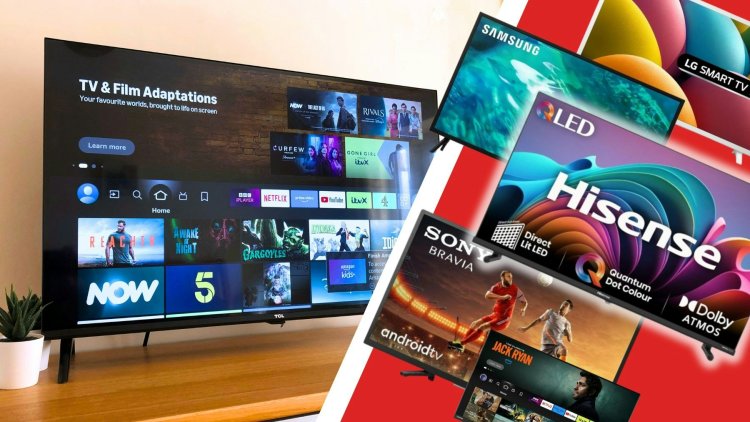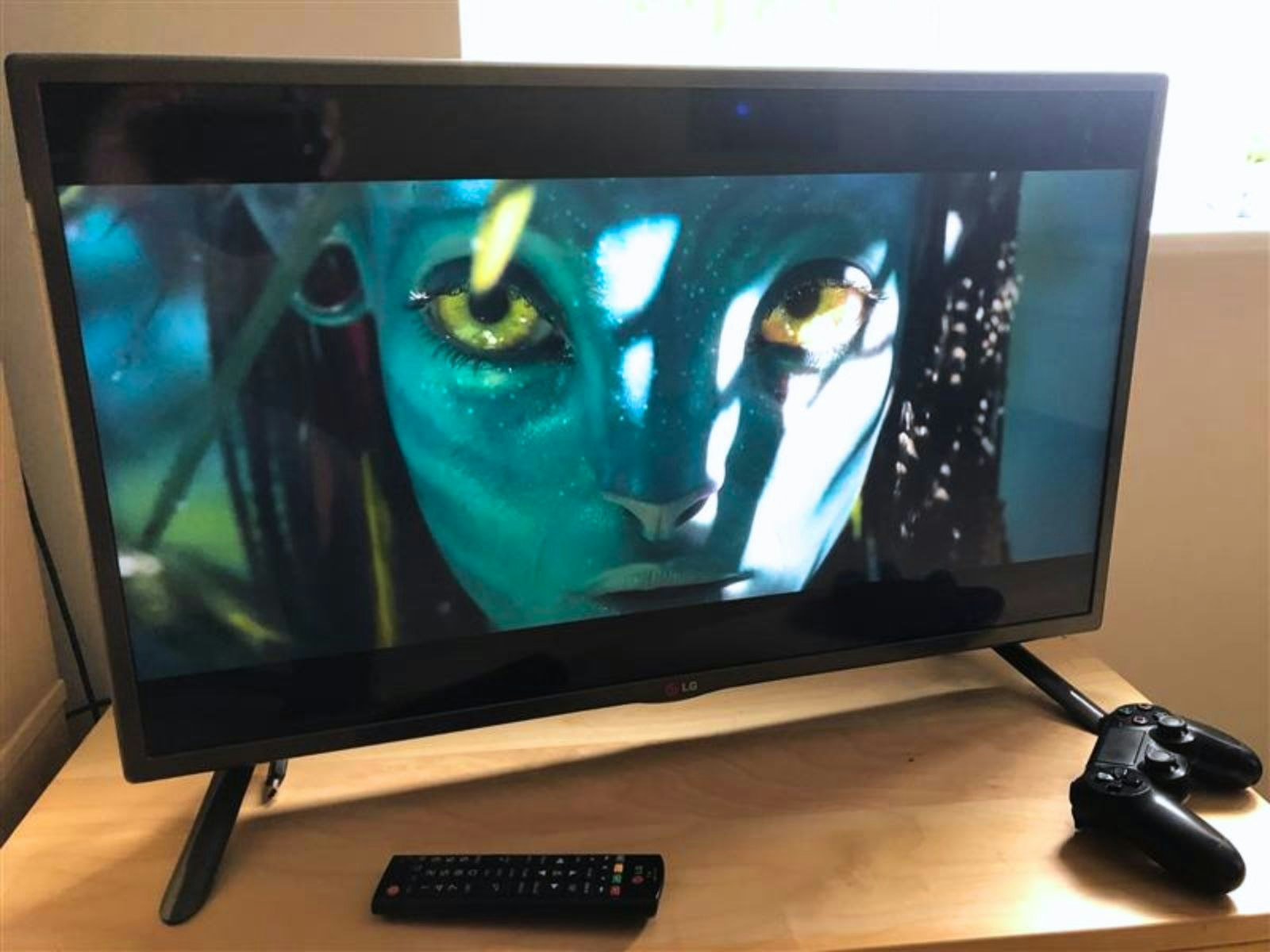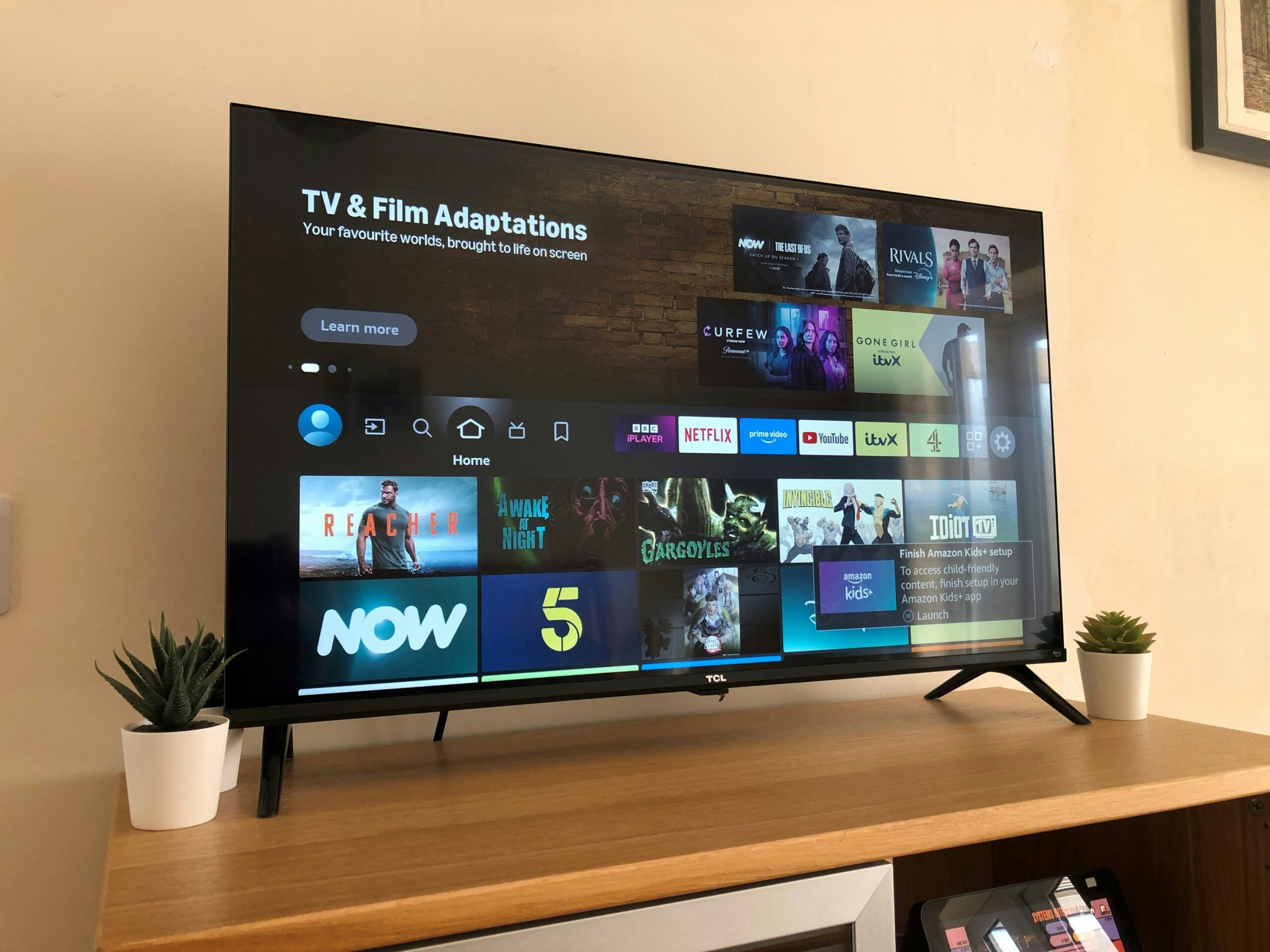These Are The Best 32-Inch Smart TVs Of 2025: Small Screens With Big Features
A smaller set doesn't mean missing out on quality picture and sound.

As amazing as they are, not all of us have the spare space or cash for some of the largest and most feature-packed TVs on the market. Yes, a 65-inch OLED TV will blow you away in a showroom as it plays 4K HDR clips from movies like Avatar: The Way Of Water, but sometimes even a 55-inch smart TV won't comfortably fit into a living room. Or, perhaps you're looking to stream your favourites in that spare room when the big TV's been hijacked by the household's resident reality fan. Either way, that's where the best 32-inch smart TVs come in.
With movies hitting the small screen almost as fast as they're shown at the cinema, streaming the latest releases at home is fast becoming the norm. While a 32-inch TV won't offer the same experience as a trip to the big screen, if you're settling in for a movie night or TV marathon having a set with a wide range of smart apps will deliver a huge amount of choice, thanks in part to the rise of subscription streaming services like Apple TV+.
Our go-to brands are here, with the likes of Samsung and Hisense providing some excellent QLED and HDR models that ensure vibrant colour, great contrast levels and deep blacks. If you've got your heart set on 4K resolution, a traditional 32-inch TV won't reach these heights. However, a monitor equipped with smart apps, speakers and a remote might – and we've found one that delivers that Ultra High Definition detail.

As for sound, most 43-inch TVs and smaller are often notorious for tinny output with poor bass. That's why we always recommend investing in one of the best soundbars to sit neatly underneath the screen. We've had the pleasure of listening to ones which support advanced audio formats like Dolby Atmos. However, we've still selected TVs with better than average built-in audio where possible (for those who don't want the extra clutter of a soundbar). So, let's take a look at the 32-inch TVs which are perfect for the biggest shows, games and films.
How we chose the best 32-inch TVs
We've selected the best 32-inch TVs based on reliable and trusted brands, average user reviews, price, and suitability for each use case. We look carefully at the technical specifications of all products before recommending them to ensure that they will meet buyers' requirements without the need for costly additions to work as intended. With all of our selections for the best 32-inch TVs, we've looked for a balance of price with display quality, picture resolution, audio features, build quality and overall design. We also look for good connectivity options and a wide range of smart TV apps. All of our writers may also choose products based on hands-on experience where we own or have reviewed products ourselves. Retailers are selected based on price, availability and reputation as reliable and trusted sellers. Find out more about how we recommend products.
All prices are correct at the time of writing. Prices, stock and deals are subject to change without notice.
Best 32-inch TVs in 2025
Expert's choice
As a fully-featured Full HD QLED set, we think that the Hisense 32 inch Full HD QLED Smart TV 32A5NQTUK offers a fantastic array of technical features at a sensible price. The snappy and intuitive menu with easy access to all of your favourite apps seals the deal.
Although the brand is synonymous with quality by default for many, we can't ignore the brilliant Samsung Smart Monitor M7. Given that many manufacturers don't bother to fit a 4K panel into TVs of this size, this monitor is a 32-inch smart TV in all but name. After all, it does have built-in smart apps, speakers and a remote control. It's only lacking a tuner and aerial input, but we'll sacrifice access to live TV in the name of a 4K picture.
What to look for in a 32-inch TV
Although you're not likely to find cutting-edge features like 4K OLED panels, AI picture processing, Atmos sound and super-high refresh rates in a 32-inch TV, there are some gems to be found. As our recommendations show, you can always find a TV loaded with smart apps, but what other features do you really need?

The best 32-inch TV features for film fans
For those who prioritise image clarity and quality, plus impeccable colour accuracy, a QLED or OLED TV would normally be the way to go. As each pixel is self-illuminating, OLEDs offer amazing contrast levels and colour for film fans. However, 32-inch OLED TVs are unheard of due to the cost of the panels themselves. Thankfully, QLED technology has come a long way in recent years, with numerous local dimming zones in their backlights to keep blacks almost as deep and true as OLED. They tend to be more budget-friendly too, and deliver exceptionally bright images, making them a solid option for rooms with a lot of natural light.
With the addition of HDR (High Dynamic Range) for over a billion colours, you'll experience a stunning picture that will more closely match what the director had in mind. Go for the superior HDR10+ or Dolby Vision version of HDR if you can find it.
A sound choice for movies
When it comes to sound, seek out TVs that support advanced surround formats like DTS or Dolby Atmos. For an even better cinematic experience, consider upgrading your audio setup with a budget soundbar that can support those formats.
32-inch TVs for telly addicts
Love keeping up with the latest shows? You'll likely want many of the same features that appeal to movie buffs. However, there are a couple of additional factors to bear in mind.
EPGs and recording
We've mentioned app availability above, but for those who watch most of their shows via their Freeview aerial, we recommend looking closely at the Electronic Programme Guide (EPG) of the TV. If the look and feel of guides like these are a bugbear of yours, you'll want one that's quick to load, fast, responsive and easy to read. Some TVs will also let you record a program (or even a whole series) using the guide when used in conjunction with a USB stick. If you're following multiple shows on live TV, you may want a model that can do this. We recommend using an external USB drive with at least 256GB of space to ensure you never miss an episode.
Catch-up services
But its not all about having a digital aerial input. If you like to catch up on missed programmes, look for the Freeview Play app for on-demand viewing. You’ll also find popular catch-up services like BBC iPlayer, ITV Hub, and Channel 4.
All that said, most movie and TV fans' must-have apps are usually from paid platforms like Netflix and Amazon Prime Video. Before buying, make sure your favourite shows (and their streaming apps) are supported.
32-inch TVs for gamers
Anyone gaming on their Nintendo Switch will be getting a serious upgrade when they dock it with a 32-inch TV. Whether you game on a PS5, Xbox Series X or a modern retro console like the Evercade, you'll want to put these features to the top of your gaming TV wish list:
HDR
You can read more about High Dynamic Range below. In short, if you're new to HDR content, you'll see an unparalleled colour depth and clarity for games that support all of those extra colours.
Refresh rate (Hz)
Look for a TV with a high and adaptive refresh rate. Having this ensures that, when playing a game at high and variable frame rates, the screen displays each frame smoothly. The payoff? Fluid, sharp motion without screen tearing or stuttering. For the best experience, look for a model with a minimum 120Hz refresh rate and support for variable refresh rate (VRR). This feature may be branded as G-Sync or FreeSync, depending on the manufacturer.
Imagine Monster Hunter Wilds or the Switch's Xenoblade Chronicles X on a TV with features like these. Breathtaking, even on a 32-inch screen.
Smart streaming
All of these uses aside, it's worth considering your streaming needs. All 32-inch smart TVs tend to have a similar array of popular apps available – like Disney+, YouTube, Amazon Prime, and Netflix. However, a minority of others (like Discovery+ and Peacock) may not be present. It all depends on the model you go for, so we recommend checking the specs to make sure the apps or channels you want are available.
One last thing to note are the pros and cons of simply upgrading an existing non-smart TV (or one that's become painfully slow) by plugging in a separate TV streaming device. While gadgets like Fire TV Sticks and Roku Streaming Sticks slot into a HDMI port and offer functionality and value, they do come with downsides. Firstly, if your old 32-inch TV only has one HDMI input, it'll be hogged by the stick – leaving you plugging and unplugging for things like consoles and Blu-ray players. Secondly, depending on the orientation of your TV's HDMI port, these sticks can protrude towards the wall behind, making it tricky or even impossible to add one to a wall-mounted TV (without buying a short HDMI adapter cable).
It'll fit, but will it fit nicely?
Many 32-inch TVs are impressively slim, making them ideal for both wall-mounting and stand-mounting. Yes, TVs this size take up even less space than they used to thanks to thinner bezels, and that's great news. However, don't skip measuring-up before you buy. Your TV should be positioned for comfortable viewing, with wall-mounting the most stylish and space-saving choice. But keep an eye on the height – too high, especially above a tall fireplace mantel, might look good but can result in uncomfortable viewing.

TV terminology
Here's a short glossary of TV technical terms for those new to the world of OLEDs, QLEDs, HDR and more.
4K and Ultra HD (UHD) versus Full HD
4K, also known as 4K UHD, has a resolution of 3840 x 2160 pixels. That's roughly 8.3 million of the little blighters, which is how a 4K TV delivers four times the detail of a standard Full HD display at 1920 x 1080 pixels. If you want the clearest, most detailed picture, 4K remains the best choice – but you may find your choice limited in 32-inch models.
High Dynamic Range (HDR) and Dolby Vision
High Dynamic Range (HDR) technology expands the number of colours that a standard TV produces (16.7 million) to over a billion colours. This isn't just about making images look brighter or more vibrant. Provided the content itself supports HDR, you'll be set for better, more accurate tones and shades. The net result is stunningly realistic visuals with added depth and precision.
HDR10+ takes this even further by incorporating extra metadata, allowing for more precise adjustments and an even more refined viewing experience. Dolby Vision, Dolby's take on HDR10 and HDR10+, pushes the boundaries of colour accuracy and contrast, delivering exceptional depth and lifelike realism. Widely regarded as one of the top HDR formats, Dolby Vision remains a leading choice for both film fans and premium televisions.
LED and LCD
A panel of LEDs (or Light-Emitting Diodes) are a thin and efficient light source for LED and OLED TVs. LEDs provide the backlight for an LCD (Liquid Crystal Display) panel, which is responsible for producing the image you see. Without this illumination, the screen would appear almost completely dark. While LED TVs, including many 4K models, remain widely available, they do rely on older technology. Their affordability is a plus, but because brightness is achieved through a backlight rather than self-illuminating pixels, contrast and black levels are often substandard.
Micro LED and Mini LED
You're highly unlikely to find a 32-inch TV with either of these technologies. Unlike conventional LED TVs, Micro LED displays boast not just high resolution but also individually controllable microscopic LEDs – removing the need for a broad backlight. This design results in exceptional blacks, wide viewing angles, and brightness levels that often surpass other technologies, including OLED. However, these cutting-edge screens come at a steep price and are typically only available in larger sizes.
Mini LED TVs are the same but with larger LEDs that aren't small enough to form individual pixels. Instead, like traditional LED TVs, they serve as an advanced backlight for an LCD panel. Localised dimming in specific areas of the screen (also known as 'dimming zones') helps replicate the deep blacks seen in Micro LED and OLED displays. Since Mini LED technology is still closely tied to LCDs, these TVs are significantly more affordable than Micro LED, OLED, and many QLED models.
OLED
OLEDs, or Organic Light-Emitting Diodes, are made from organic compounds that emit light on their own. Each one is an individual pixel, allowing for precise control over brightness and colour. Cinephiles value these for their vibrant and accurate colours, exceptional contrast, and excellent clarity. But, perhaps the aspect they're most coveted for is OLED's ability to achieve true black levels. Each pixel can be dimmed or completely switched off, resulting in shadows that are deep and rich. Cinematic experiences with lots of atmosphere like Blade Runner 2049, or games such as Silent Hill 2, reach new levels of darkness. While OLEDs don't reach the extreme brightness levels of some other panel types, they still deliver superior image quality and are a top choice for movie and TV lovers.
QLED
Quantum LED TVs (QLEDs) have come a long way since launch. Now they use their Quantum Dot-enhanced backlights and increasingly clever tech to replicate the deep blacks, striking contrast, and vibrant colours of OLED displays. They come extremely close to OLED and so represent a quality affordable alternative. You're likely to find quite a few of these in 32-inch TVs as the panels, although a bit costly, aren't as expensive as OLEDs. Lastly, QLED TVs excel at delivering superior brightness levels which is ideal for viewing in bright rooms. Viewing angles aren't quite on par with OLED, but QLEDs are comparable in most other aspects. We recommend this panel type for anyone looking for a quality 32-inch TV.
Common screen resolutions
HD (or Half HD): 1280×720
Full HD: 1920×1080
4K / 4K UHD: 3840×2160
Latest updates
This article was first published in April 2025. Future relevant additions and amendments will be noted here.
Chris Duffill is a Senior Tech Writer and Reviewer. He specialises in home entertainment and audiovisual tech, including TVs, projectors, speakers, amplifiers, turntables and more.
Having worked in video production, photography and graphic design, he has decades of professional experience with various display technologies. He's owned TVs of various sizes and specs, several home cinema projectors and also set up his own surround sound systems, including Dolby Atmos. He's a lifelong TV and movie fanatic with a Masters in Screenwriting from the UEA.
What's Your Reaction?























